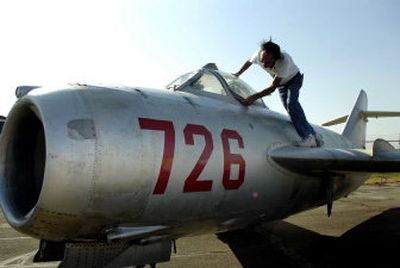Museum still waiting on funds

Twenty-five years ago, American sightings of Russian-built jets usually were the result of military planners wanting to test the weapons of our Cold War enemy.
Last week, a Russian-designed MiG-17 jet fighter took on a new role as a historical marker of how differently the world’s two superpowers see each other now.
Donated last year to Spokane’s Armed Forces & Aerospace Museum, the aircraft will become part of the museum’s airplane exhibition someday if organizers are successful in raising their first-phase target of $6 million. They have raised about $1 million so far.
The museum is to be built on land leased from Spokane International Airport and will include a collection of regional civilian and military aeronautic history.
Last week, museum volunteers tractored the 9,000-pound MiG to a temporary parking spot next to a hangar belonging to XN Air, a company that installs aviation equipment on commercial and private aircraft.
XN founder Al Hale looked over the MiG-17 that arrived at his business Wednesday and had to smile.
“It’s a good airplane for us to showcase. We’ll polish it up and use it as an attention-getter,” he said.
Clad in its original silver aluminum, the single-seat jet looks ready to fly – if the pilot knows how to read Polish. The aircraft was built in Poland for the Polish Air Force in 1960. Though designed in the former Soviet Union, that country allowed companies in Poland and China to manufacture the jets and sell them to other Eastern bloc countries.
The airplane flew until 1991, records show. After the collapse of the Soviet Union in the early 1990s, it was one of a group of 14 MiGs sold by Poland to American plane collectors in the Phoenix area.
Two Spokane business partners, Greg Van Houten and Richard J. Smith, owned hangars used by the collectors to store the MiGs in Glendale, Ariz. When the plane collectors fell behind in rent, they gave this MiG-17 to Van Houten and Smith.
Smith, a retired Air Force fighter pilot who flew combat missions during the Korean War, planned to bring the plane to Spokane and fully restore it, but he died in 2003.
Van Houten, who doesn’t fly, decided to donate it in Smith’s memory to the volunteers working on creating the aerospace museum. That regional project was spawned by the Air Force’s decision in 1996 to turn Fairchild Air Force Base’s museum into an unstaffed “historic holding facility,” sparking fears among local aviation enthusiasts that its collection of artifacts and exhibits would be lost.
Last fall, museum volunteers drove to Glendale, disassembled the MiG and loaded its pieces onto a flatbed truck. Until this week, the plane either sat on the truck or was parked on a side road at the south end of the airport.
Unlike many pieces of aerospace history, the MiG still has everything it needs to be flown, Van Houten said.
“We were told (in 2003) that there were maybe 25 flyable MiG-17s still around,” he said. “That was a few years ago, and I heard two more have crashed since then.”
The jet’s logs indicate the plane was used by the Polish Air Force to confront U.S. warplanes or spy planes flying over Poland, probably in the 1980s, said Van Houten.
Stan Roth, office manager for the museum group, said the MiG will help round out the story of Fairchild Air Force Base’s involvement in the Vietnam War.
“The B-52 that the Air Force has committed to give (the museum) has a single red star on it. That’s because the tail gunner on that plane shot down one of these airplanes (during the war),” Roth said.
“So it’s really a complementary story. It was one of the adversarial aircraft our planes encountered during that war.”
Despite being in good condition, the MiG isn’t ready to fly, noted Brenton Spencer, a museum volunteer who was an Air Force mechanic for two decades. It would take a Federal Aviation Administration inspection and registration before a pilot could take it up for a test flight, he said.